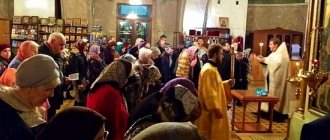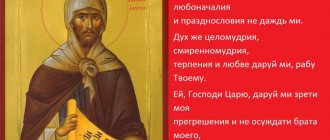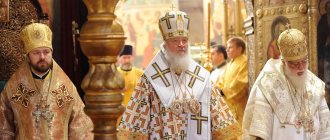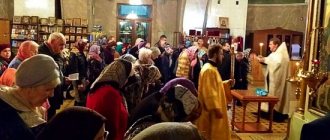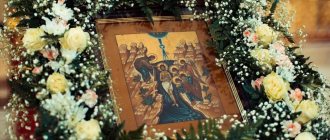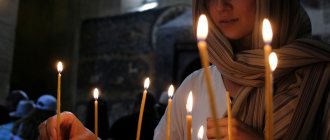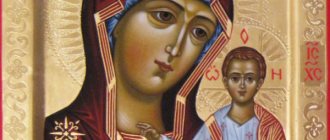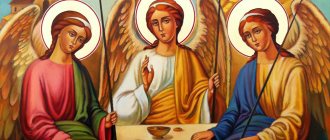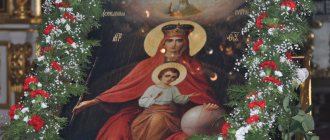Prayer to the Lord before starting icon painting
Lord Jesus Christ, our God, Who is indescribable by the nature of the Divinity, and for the sake of the salvation of man in the last days from the Virgin Theotokos Mary indescribably incarnated, and who was so gracious in the flesh we describe being, for whom You imprinted the holy image of Your most pure face on the holy veil, and with it the illness You healed Prince Abgar, and You enlightened his soul to know our true God, Who by the Holy Spirit admonished Your divine Apostle and Evangelist Luke to paint an image of Your Most Pure Mother, holding You like a baby in Her arms, and saying: “Grace from Who was born of Me, for My sake, be it with this image”: You, Master, God of all, enlighten and enlighten the soul, heart and mind of Thy servant [ or Thy servant ]
(name)
, and direct his
[ her ]
, into sinless and fairly depict Your life, Your Most Pure Mother, and all the saints, for Your glory, for the sake of the decoration and splendor of Your holy Church, and for the remission of sins of all who spiritually venerate the holy icons, and reverently kiss them, and veneration for those who relate to the Archetype.
Deliver him [ her ]
from every devilish obsession, when he succeeds in Your commandments, through the prayers of Your Most Pure Mother, the holy glorious Apostle and Evangelist Luke and all the saints. Amen.
Where and how to consecrate an icon
An icon created with your own hands must be taken to church . The priest who gave the blessing will bless her after the craftswoman confesses and receives communion on Sunday during the Liturgy.
In some cases, the priest may refuse consecration:
- The image on the icon is not Orthodox , but Catholic . Unknowingly, a craftswoman may buy the wrong set.
- A woman cannot receive communion for any reason.
- The priest did not give his blessing and considers embroidery of icons to be a displeasing task.
To avoid unpleasant moments, it is recommended to first consult with a clergyman, ask what is the right thing to do, and then get to work, following all the instructions.
Apostle and Evangelist John the Theologian
First prayer
O great apostle, loud-voiced evangelist, most graceful theologian, seer of ineffable revelations, virgin and beloved confidante of Christ John! Accept us, sinners, who come running under your strong intercession. Ask the All-Bountiful Lover of Mankind, Christ our God, Who poured out His Blood for us, His indecent servants, before your eyes, so that He may not remember our iniquities, but may He have mercy on us and deal with us according to His mercy: may He grant us health of soul and body, all prosperity and abundance, instructing us to turn it into the glory of Him, the Creator, Savior and our God, and at the end of our temporary life, may He deliver us from the merciless torturers in the air ordeals, and thus may we reach, led and covered by you, the Mountain of Jerusalem, You have seen His glory in revelation, but now you enjoy endless joys. O great John! Save all Christian cities and countries, this temple, those serving and praying in it, from famine, destruction, cowardice and flood, fire and sword, invasion of foreigners and internecine warfare; deliver us from all troubles and misfortunes and with your prayers turn away the righteous wrath of God from us, and ask for His mercy for us, so that together with you we will be worthy to glorify in the uneven days the most holy name of the Father and the Son and the Holy Spirit forever and ever. Amen.
Second prayer
O great and all-praised apostle and evangelist John the Theologian, confidant of Christ, our warm intercessor and quick helper in sorrows! Pray to the Lord God to grant us forgiveness of all our sins, even if we have sinned from our youth throughout our life in deed, word, thought and all our feelings; at the end of our souls, help us sinners (names)
, get rid of airy ordeals and eternal torment, and through your merciful intercession we glorify the Father and the Son and the Holy Spirit, now and ever and unto ages of ages. Amen.
What rules must be followed when embroidering icons?
Rule #1. Blessing of the Priest
Priest Alexy's opinion:
“It’s a wonderful thing – a gift from God – to be involved in the creation of icons. As a matter that is intended to be soul-saving and pleasing to God, it requires the blessing of the clergy.”
It is necessary to show the clergyman a diagram or booklet from the embroidery kit so that he approves of your choice and gives a blessing for sewing the icon (“blessing is Divine help, God’s approval, in church usage it means the permission of the clergy”).
The fact is that at present there are manufacturing companies that, pursuing exclusively commercial goals, produce patterns and kits for embroidering icons that do not comply with Orthodox canons. It is, of course, advisable to undergo the great sacrament of confession and communion. Because you are about to begin creating a liturgical image. And this must be done with a pure soul and a kind heart.
Rule #2. Prayer before starting work on embroidery
When starting to embroider an icon, you need to read a prayer. There are special prayers for icon painters and craftsmen, but you can read any prayer that you know or turn to the saint whose image will be embodied in embroidery.
Opinion of Archpriest Georgy Schmid:
“...embroidery of an image should indeed be accompanied by prayer. Which? I think addressed to the One whose image you are working on.”
Rule #3. The pious life of a needlewoman
While embroidering Orthodox icons, one must observe fasting, limit idle entertainment, exclude alcohol, fatty foods, and animal products from the diet, and give up smoking. It is also advisable for the embroiderer to read canons, akathists, and other prayers. Reading prayers allows you to fully concentrate on creating an icon, understand your aspirations and torments, change your life for the better, and find peace of mind.
Opinion of priest Vyacheslav Bodan:
“...embroidery or painting an icon is not a hobby, not handicraft or anything like that. For those people for whom this was a matter of life, the creation of an icon was always inextricably linked with fasting and prayer, with a special mood of the soul, a rhythm and structure of life that was different from ordinary days.”
In the process of embroidering an icon, the craftswoman receives peace, is filled with piety, and is elevated spiritually. All vain thoughts and problems go away, only the soul remains.
There are many examples when, after sewing an Orthodox icon, the master was cured of a long and serious illness, and got rid of a series of troubles that had previously visited him.
Rule #4
When embroidering an icon, you need to drive away bad and sinful thoughts, you need to think only about the good, the good. You cannot get to work during a quarrel, family troubles, or in a state of mental anger, resentment, or envy. Girls and women on critical days are not supposed to touch the embroidery of icons.
Many people are interested in the question: is it possible to embroider faces and hands?
The answer from the clergy is unequivocal - no. The fact is that their image is strictly controlled by the canons. To paint them with paints you need permission from fairly high church officials. Therefore, many priests are against completely stitching icons with a cross and are more relaxed about ready-made kits for embroidering icons with beads. As a rule, such sets are designed taking into account all iconographic canons. Faces, hands and details that require special care are initially applied to the fabric with paint.
Rule #5
The finished work must be framed in an icon case (an icon case is a frame or ark (box) with glass in which the icon is placed). And then consecrated in the temple .
An icon embroidered with your own hands has a huge energy charge, because when creating it, the craftswoman puts a piece of her soul, good intentions, love and humility.
Apostle and Evangelist Luke
Troparion, tone 5
The apostolic acts of the narrator and the Gospel of Christ are a luminous descriptor, praised by Luke, the glorious existence of the Church of Christ, with the sacred hymns of the holy apostle we praise, as a physician existing, human infirmities, natural ailments and ulcers of souls, healing and praying unceasingly for our souls.
Kontakion, tone 2
Let us praise the true piety of the preacher and the unspeakable mysteries of the rhetorician, the ecclesiastical star, Luke the Divine: for his word was chosen, with Paul the wise teacher of tongues, the only one who knows the heart.
Troparion, tone 3
Apostle Saint Luke, pray to the merciful God that he may grant remission of sins to our souls.
Kontakion, tone 4
As the Church has always acquired the bright star, Apostle Luke, she is enlightened by your many miracles. In the same way we call to Christ: save those who honor by faith the memory of Your Apostle, O Many-Merciful One.
Rev. Andrei Rublev, icon painter
Troparion, tone 3
Illustrated by the rays of Divine light, Reverend Andrew, you knew Christ - God’s Wisdom and Power and with the icon of the Holy Trinity you preached the Unity in the Holy Trinity to the whole world, but we cry out to you with surprise and joy: having boldness towards the Most Holy Trinity, pray to enlighten our souls.
Kontakion, tone 8
From youth to Divine beauty, you were a wonderful icon painter, rushing to the lands of Russia, and, jealous of your God-bearing teacher, you adorned you with the radiance of virtues, Reverend Andrew, and thus our praise and joy appeared to the Church.
Prayer to St. Andrei Rublev
O sacred head, reverend father, most blessed Abbot Andrew, do not forget your poor to the end, but always remember us in holy and auspicious prayers to God: remember your flock, which you yourself shepherded, and do not forget to visit your children, pray for us, father sacred, for your spiritual children, as you have boldness towards the Heavenly King: do not keep silent to the Lord for us, and do not despise us, who honor you with faith and love: remember us unworthy at the Throne of the Almighty, and do not stop praying for us to Christ God, for You have been given the grace to pray for us. We do not imagine that you are dead: even though you have passed away from us in body, but remain alive even after death, do not depart from us in spirit, keeping us from the arrows of the enemy and all the charms of the demonic and the machinations of the devil, to our good shepherd even more than the relics your cancer is always visible before our eyes, but your holy soul with the angelic hosts, with the disembodied faces, with the heavenly powers, standing at the throne of the Almighty, worthily rejoices, knowing that you are truly alive even after death, we fall down to you and we pray to you: pray about us to the Almighty God, about the benefit of our souls, and ask us time for repentance, so that we may pass from earth to heaven without restraint, and from bitter ordeals, demons of air princes and from eternal torment, may we be delivered from eternal torment, and may we be heirs of the Heavenly Kingdom with all the righteous, from all eternity have pleased our Lord Jesus Christ: to Him belongs all glory, honor and worship, with His Father without beginning, and with His Most Holy and Good and Life-giving Spirit, now and ever, and unto ages of ages. Amen.
Troparion to the Saint, tone 8
In you, Father, it is known that you were saved in the image of the cross, you followed Christ, and you taught in deed to despise the flesh, for it comes: be diligent about the souls, things more immortal: in the same way your spirit rejoices with the Angels, Reverend Andrew.
Kontakion to the Saint, tone 2
Having divinely armed yourself with spiritual purity and unceasing prayers like a spear in your hand, you prosecuted the demonic host of Andrei, pray unceasingly for all of us.
Greatness to the Reverend
We bless you, Reverend Father Andrew, and honor your holy memory, teacher of monks and interlocutor of Angels.
Work on the icon “St. Helena”
Making an icon with your own hands assumes that you can embroider in vertical and horizontal rows. You can start from both the bottom and the top. The icon “St. Helena” is considered the simplest in execution.
According to experienced craftswomen, to make the Saint Helena icon, it is most correct to start embroidering from the upper right corner and move in horizontal rows. The thread is attached to the wrong side, then brought to the “face” of the work in the lower right corner.
The master class will tell you how to properly embroider the face of the Saint Helena icon. Follow it, and you will certainly succeed.
Work process
The process of embroidering the icon “St. Helena” is as follows:
- a bead (corresponding color) is strung on a needle;
- the needle is inserted into the upper left corner of the canvas cell;
- the thread is carefully pulled up and the bead is sewn on (when working with beads, it is important to remember that the work does not get lost. To do this, the first and last beads are sewn twice);
- the second bead is strung, and in this way the entire row is worked out. Carefully follow the order and adherence to the scheme. The color should be selected in accordance with the scheme;
- further, the process of embroidering the icon “St. Helena” involves following in the opposite direction, from left to right. To do this, the needle is taken out from the upper left corner of the canvas cell, and, after stringing the bead, it is inserted into the lower right edge of the cell;
- The location of the thread is of great importance. When working on fragments, you must remember that pulling the thread on the wrong side can ruin the design;
- Embroidering in parts is of no small importance. You should finish one side first, then move on to the other.
Important to remember
If one row turns out to be longer or shorter than the previous one, you can sew the last bead twice, and then return to the wrong side and use small stitches to reach the required area. If the color of the sewn bead accidentally turns out to be inappropriate, then you can use round nose pliers or pliers. Having carefully “seen through” the erroneous element, sew on the bead whose color matches the pattern.
To all the saints and ethereal heavenly powers
Holy God and rest in the saints, glorified by the thrice-holy voice in heaven from Angels, praised on earth by man in His saints: having given grace to each by Thy Holy Spirit according to the bestowal of Christ, and by that ordaining Thy holy Church to be Apostles, prophets, and evangelists , you are shepherds and teachers, preaching in their own words. You yourself, who act all in all, have accomplished many holiness in every generation and generation, having pleased you with various virtues, and leaving us with an image of your good deeds, in the joy that has passed, prepare, in it the temptations themselves were, and help us who are attacked. All these saints and (the name of the saint whose icon they were going to paint or embroider)
Remembering and praising their godly lives, I praise You Himself, who acted in them, and believing in Your goodness, the gift of being, I diligently pray to You, Holy of Holies, to grant to me a sinner to follow their teaching, moreover, by Your all-effective grace, the heavenly ones with them will be worthy of glory, praising Your most holy name, the Father and the Son and the Holy Spirit forever. Amen.
To the list of prayers
Embroidery techniques
embroider an icon using any technique - satin stitch, cross stitch, beads, gold and silver threads. The most difficult thing to master is the technique of sewing on beads. The beads should lie equally evenly and be located in the same direction. To get an even row, you need to insert the needle into the upper right corner of the cage, then string the beads and then make a puncture in the lower left corner. To avoid mistakes, it is recommended to always keep the hoop in one position without turning it over.
There are two techniques for sewing beads:
- Sew on individually , making a puncture after each bead. It takes more time, but the work will be durable. Only the first and last bead are stitched twice.
- Cast on a whole row at once , then go back and attach beads or one at a time.
You can create icons from the center. In this case, the beads are arranged in a spiral. Another method is called chaotic - the workpiece is embroidered in pieces: first the main lines and sections of the same color, then the secondary ones.
